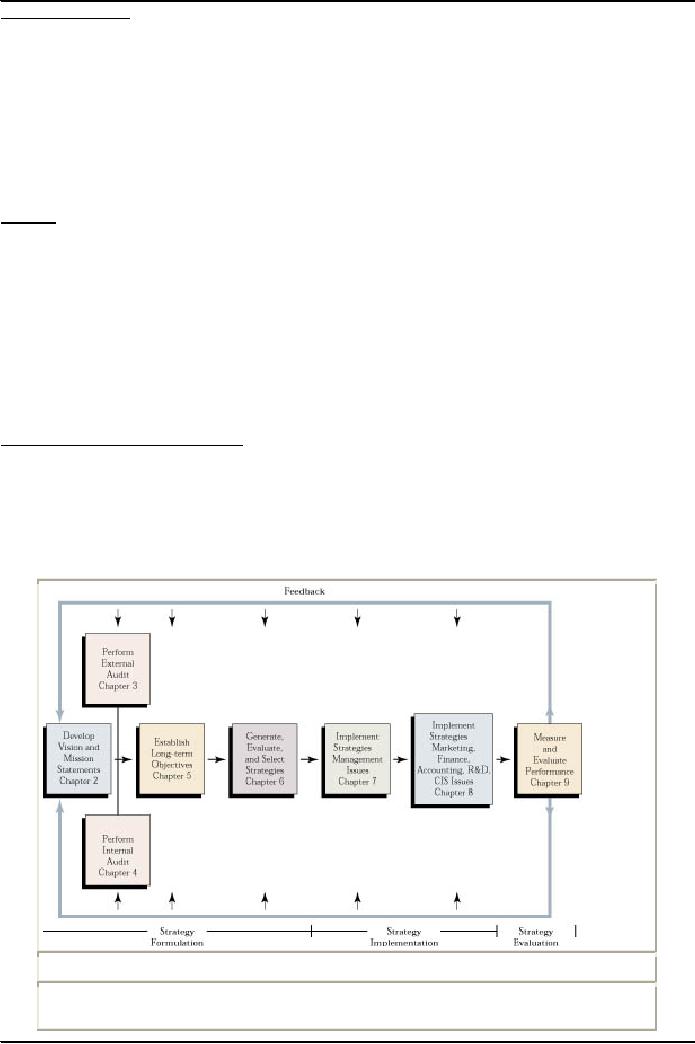 |

Strategic
Management MGT603
VU
Lesson
3
INTERNAL
FACTORS & LONG TERM
GOALS
Objectives:
After
reading this lecture you
will be able to know
that:
What
are Internal Factors?
1.
Financial ratios
2.
Performance levels
3.
Industry averages
4.
Survey results
What
is the importance of strategies in achieving
Long term objectives?
What
are the Financial and Non
financial benefits of Strategic
Management?
Long-Term
Objectives
Objectives
can be
defined as specific results
that an organization seeks to achieve in
pursuing its basic
mission.
Long-term
objectives represent
the results expected from pursuing
certain strategies. Strategies
represent the
actions
to be taken to accomplish long-term
objectives. The time frame
for objectives and
strategies should
be
consistent, usually from two
to five years.
Objectives
are essential for organizational
success because they state
direction; aid in evaluation;
create
synergy;
reveal priorities; focus
coordination; and provide a
basis for effective planning,
organizing,
motivating
and controlling activities.
Objectives should be challenging,
measurable, consistent,
reasonable,
and
clear. In a multidimensional firm,
objectives should be established for the
overall company and for
each
division.
The
Nature of Long-Term
Objectives
Objectives
should be quantitative, measurable,
realistic, understandable, challenging,
hierarchical,
obtainable,
and congruent among organizational units.
Each objective should also be associated
with a time
line.
Objectives are commonly stated in terms
such as growth in assets,
growth in sales, profitability,
market
share,
degree and nature of
diversification, degree and
nature of vertical integration, earnings
per share, and
social
responsibility. Clearly established
objectives offer many
benefits. They provide direction,
allow
synergy,
aid in evaluation, establish priorities,
reduce uncertainty, minimize conflicts, stimulate
exertion, and
aid
in both the allocation of resources and
the design of jobs.
Long-term
objectives are needed at the corporate,
divisional, and functional
levels in an organization. They
are
an important measure of managerial
performance.
Clearly
stated and communicated
objectives are vital to
success for many reasons.
First, objectives help
stakeholders
understand their role in an
organization's future. They
also provide a basis for
consistent
decision
making by managers whose values
and attitudes differ. By reaching a
consensus on objectives
during
strategy-formulation activities, an organization can
minimize potential conflicts later
during
implementation.
Objectives set forth organizational
priorities and stimulate
exertion and
accomplishment.
They
serve as standards by which
individuals, groups, departments,
divisions, and entire organizations
can
be
evaluated. Objectives provide the
basis for designing jobs
and organizing activities to be performed in an
organization.
They also provide direction
and allow for organizational
synergy.
Without
long-term objectives, an organization
would drift aimlessly toward
some unknown end! It is
hard
to
imagine an organization or individual being
successful without clear
objectives. Success only
rarely occurs
by
accident; rather, it is the result of hard
work directed toward
achieving certain
objectives.
Strategies
Strategies
are
the means by which long-term
objectives will be achieved.
Business strategies may
include
geographic
expansion, diversification, acquisition, product
development, market penetration,
retrenchment,
divestiture,
liquidation, and joint
venture.
Strategies
are potential actions that
require top management decisions
and large amounts of the
firm's
resources.
In addition, strategies affect an
organization's long-term prosperity,
typically for at least
five
years,
and thus are
future-oriented. Strategies have
multifunctional or multidivisional
consequences and
require
consideration of both external and
internal factors facing the
firm.
9

Strategic
Management MGT603
VU
Annual
Objectives
Annual
objectives are
short-term milestones that organizations
must achieve to reach
long-term objectives.
Like
long-term objectives, annual
objectives should be measurable,
quantitative, challenging,
realistic,
consistent,
and prioritized. They should be
established at the corporate, divisional,
and functional levels in
a
large
organization.
Annual
objectives should be stated in terms of
management, marketing,
finance/accounting,
production/operations,
research and development, and
information systems accomplishments. A
set of
annual
objectives is needed for
each long-term objective.
Annual
objectives are especially
important in strategy implementation,
whereas long-term objectives
are
particularly
important in strategy formulation.
Annual objectives represent the
basis for allocating
resources.
Policies
Policies
are
the means by which annual
objectives will be achieved.
Policies include guidelines, rules,
and
procedures
established to support efforts to
achieve stated objectives.
Policies are guides to
decision making
and
address repetitive or recurring
situations.
Policies
are most often stated in
terms of management, marketing, finance/
accounting,
production/operations,
research and development, and computer
information systems activities.
Policies
can
be established at the corporate level and apply to an
entire organization, at the divisional level and
apply
to
a single division or at the functional
level and apply to particular operational activities
or departments.
Policies,
like annual objectives, are
especially important in strategy
implementation because they outline
an
organization's
expectations of its employees
and managers. Policies allow
consistency and
coordination
within
and between organizational
departments.
The
Strategic-Management Model
The
strategic-management process best
can be studied and applied
using a model. Every model
represents
some
kind of process. The framework
illustrated in Figure 1-1 is a widely accepted,
comprehensive model
of
the strategic-management process. This
model does not guarantee
success, but it does
represent a clear
and
practical approach for
formulating, implementing, and evaluating
strategies. Relationships among
major
components
of the strategic-management process are
shown in the model.
A
Comprehensive Strategic-Management
Model
Source:
Fred R. David, "How Companies
Define Their Mission," Long
Range Planning 22,
no.
3
(June 1988): 40.
10

Strategic
Management MGT603
VU
Identifying
an organization's existing vision,
mission, objectives, and
strategies is the logical starting
point
for
strategic management because a firm's
present situation and condition
may preclude certain
strategies
and
may even dictate a particular
course of action. Every organization has
a vision, mission, objectives,
and
strategy,
even if these elements are
not consciously designed,
written, or communicated. The
answer to
where
an organization is going can be determined largely by
where the organization has
been.
The
strategic-management process is dynamic
and continuous. A change in any
one of the major
components
in the model can necessitate a change in
any or all of the other components.
For instance, a
shift
in the economy could represent a major
opportunity and require a change in
long-term objectives
and
strategies;
a failure to accomplish annual
objectives could require a change in
policy; or a major competitor's
change
in strategy could require a change in the firm's
mission. Therefore, strategy
formulation,
implementation,
and evaluation activities should be performed on a
continual basis, not just at
the end of
the
year or semiannually. The
strategic-management process never really
ends.
Application
of the strategic-management process is
typically more formal in
larger and
well-established
organizations.
Formality refers to the extent that
participants, responsibilities,
authority, duties,
and
approach
are specified. Smaller
businesses tend to be less
formal. Firms that compete
in complex, rapidly
changing
environments such as technology companies tend to be
more formal in strategic
planning. Firms
that
have many divisions, products,
markets, and technologies
also tend to be more formal
in applying
strategic-management
concepts. Greater formality in applying
the strategic-management process is
usually
positively
associated with the cost,
comprehensiveness, accuracy, and
success of planning across all
types
and
sizes of organizations.
Benefits
of Strategic management
Following
are the major benefits of Strategic
management:
Proactive
in shaping firm's
future
Initiate
and influence actions
Formulate
better strategies (Systematic, logical,
rational approach)
Financial
benefits:
Improved
productivity
Improved
sales
Improved
profitability
Non-Financial
benefits:
Increased
employee productivity
Improved
understanding of competitors' strategies
Greater
awareness of external threats
Understanding
of performance reward
relationships
Better
problem-avoidance
Lesser
resistance to change
Financial
Benefits
Research
indicates that organizations
using strategic-management concepts
are more profitable
and
successful
than those that do not.
Businesses using strategic-management
concepts show significant
improvement
in sales, profitability, and
productivity compared to firms without
systematic planning
activities.
High-performing firms tend to do
systematic planning to prepare
for future fluctuations in
their
external
and internal environments. Firms
with planning systems more
closely resembling
strategic-
management
theory generally exhibit superior
long-term financial performance relative to
their industry.
High-performing
firms seem to make more
informed decisions with good
anticipation of both short-
and
long-term
consequences. On the other hand, firms
that perform poorly often
engage in activities that
are
shortsighted
and do not reflect good
forecasting of future conditions.
Strategists of low-performing
organizations
are often preoccupied with
solving internal problems and
meeting paperwork deadlines.
They
11

Strategic
Management MGT603
VU
typically
underestimate their competitors'
strengths and overestimate
their own firm's strengths. They
often
attribute
weak performance to uncontrollable
factors such as poor
economy, technological change, or
foreign
competition.
12
Table of Contents:
- NATURE OF STRATEGIC MANAGEMENT:Interpretation, Strategy evaluation
- KEY TERMS IN STRATEGIC MANAGEMENT:Adapting to change, Mission Statements
- INTERNAL FACTORS & LONG TERM GOALS:Strategies, Annual Objectives
- BENEFITS OF STRATEGIC MANAGEMENT:Non- financial Benefits, Nature of global competition
- COMPREHENSIVE STRATEGIC MODEL:Mission statement, Narrow Mission:
- CHARACTERISTICS OF A MISSION STATEMENT:A Declaration of Attitude
- EXTERNAL ASSESSMENT:The Nature of an External Audit, Economic Forces
- KEY EXTERNAL FACTORS:Economic Forces, Trends for the 2000’s USA
- EXTERNAL ASSESSMENT (KEY EXTERNAL FACTORS):Political, Governmental, and Legal Forces
- TECHNOLOGICAL FORCES:Technology-based issues
- INDUSTRY ANALYSIS:Global challenge, The Competitive Profile Matrix (CPM)
- IFE MATRIX:The Internal Factor Evaluation (IFE) Matrix, Internal Audit
- FUNCTIONS OF MANAGEMENT:Planning, Organizing, Motivating, Staffing
- FUNCTIONS OF MANAGEMENT:Customer Analysis, Product and Service Planning, Pricing
- INTERNAL ASSESSMENT (FINANCE/ACCOUNTING):Basic Types of Financial Ratios
- ANALYTICAL TOOLS:Research and Development, The functional support role
- THE INTERNAL FACTOR EVALUATION (IFE) MATRIX:Explanation
- TYPES OF STRATEGIES:The Nature of Long-Term Objectives, Integration Strategies
- TYPES OF STRATEGIES:Horizontal Integration, Michael Porter’s Generic Strategies
- TYPES OF STRATEGIES:Intensive Strategies, Market Development, Product Development
- TYPES OF STRATEGIES:Diversification Strategies, Conglomerate Diversification
- TYPES OF STRATEGIES:Guidelines for Divestiture, Guidelines for Liquidation
- STRATEGY-FORMULATION FRAMEWORK:A Comprehensive Strategy-Formulation Framework
- THREATS-OPPORTUNITIES-WEAKNESSES-STRENGTHS (TOWS) MATRIX:WT Strategies
- THE STRATEGIC POSITION AND ACTION EVALUATION (SPACE) MATRIX
- THE STRATEGIC POSITION AND ACTION EVALUATION (SPACE) MATRIX
- BOSTON CONSULTING GROUP (BCG) MATRIX:Cash cows, Question marks
- BOSTON CONSULTING GROUP (BCG) MATRIX:Steps for the development of IE matrix
- GRAND STRATEGY MATRIX:RAPID MARKET GROWTH, SLOW MARKET GROWTH
- GRAND STRATEGY MATRIX:Preparation of matrix, Key External Factors
- THE NATURE OF STRATEGY IMPLEMENTATION:Management Perspectives, The SMART criteria
- RESOURCE ALLOCATION
- ORGANIZATIONAL STRUCTURE:Divisional Structure, The Matrix Structure
- RESTRUCTURING:Characteristics, Results, Reengineering
- PRODUCTION/OPERATIONS CONCERNS WHEN IMPLEMENTING STRATEGIES:Philosophy
- MARKET SEGMENTATION:Demographic Segmentation, Behavioralistic Segmentation
- MARKET SEGMENTATION:Product Decisions, Distribution (Place) Decisions, Product Positioning
- FINANCE/ACCOUNTING ISSUES:DEBIT, USES OF PRO FORMA STATEMENTS
- RESEARCH AND DEVELOPMENT ISSUES
- STRATEGY REVIEW, EVALUATION AND CONTROL:Evaluation, The threat of new entrants
- PORTER SUPPLY CHAIN MODEL:The activities of the Value Chain, Support activities
- STRATEGY EVALUATION:Consistency, The process of evaluating Strategies
- REVIEWING BASES OF STRATEGY:Measuring Organizational Performance
- MEASURING ORGANIZATIONAL PERFORMANCE
- CHARACTERISTICS OF AN EFFECTIVE EVALUATION SYSTEM:Contingency Planning